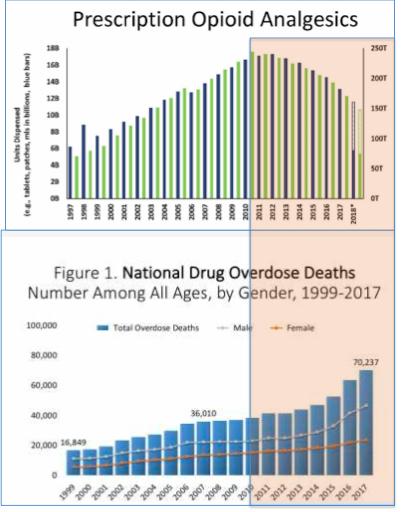In 2016 I testified at an FDA hearing about the "opioid crisis," which was starting to make its way into the news in a big way. I was the last of 15 speakers, which included, among others, addiction specialists, physicians, patient advocates and parents whose children had died from drug overdoses.
The word "fentanyl" was not mentioned even once until I spoke, when I predicted that it, which I referred to as the "devil in the room," was the real threat. Some people looked at me as if I had sprouted moose antlers. I could almost hear them thinking "what is this guy talking about?" Despite the fact that fentanyl had just begun to pour into the US two years earlier the hundreds of people in the room seemed to be oblivious to what was really going on.
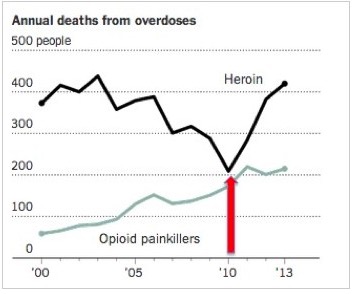
J. Bloom, Presentation to the FDA Science Board, White Oak MD, March 4th, 2016. In 2010 Purdue Pharma launched a new formulation OxyContin that was difficult to abuse. Heroin use (and death rates) took off immediately as addicts switched to street heroin, which is far more dangerous than any pill, this the surge in deaths. Fentanyl, which is more powerful, cheaper, and easier to transport, began to replace heroin soon after it entered the US three years later.
Despite rhetoric from the oblivious media and opportunistic politicians, and distorted propaganda from shady groups like Physicians for Responsible Opioid Prescribing, what was really going on was perfectly obvious. I spent the next 3+ years banging my head against the periodic table on the wall, trying to bring home the message that we were fighting the wrong battle; injectables, not pills, were the primary cause of the soaring rate of lethal opioid overdoses and the more that the pills were restricted the more deaths would occur.
Yet, it wasn't until 2018 when a study confirmed what was already obvious five years earlier (See 'Study Links Rising Heroin Deaths To 2010 OxyContin Reformulation.Duh.'). The crackdown on prescribing (1) opioid analgesics was not only associated with a spike in overdose deaths, but it also caused it.
A recent report in Public Health Reports further drives home the point that I made in 2016. "The Contribution of Prescribed and Illicit Opioids to Fatal Overdoses in Massachusetts, 2013-2015" clearly identifies fentanyl as the drug responsible for tens of thousands of people dying each year. It clarifies something that should have needed no clarifying in the first place (Figure 1).
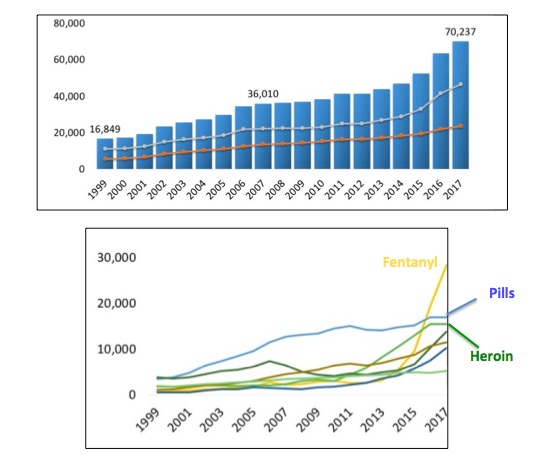
Figure 1. (Top) Overdose deaths from all opioids rose by about 30,000 between 2013-2017, virtually all of the increase (Bottom) due to fentanyl (yellow line) and heroin (green line). Deaths from prescription analgesics (blue line) remained stable during this same time. Source: National Institute on Drug Abuse.
Anyone who has been following the real story (2) shouldn't be the least bit surprised surprised about any of the following:
Of the 2916 people who died in Massachusetts between 2013-2015 (and had complete toxicology reports):
- 1789 (61%) had heroin detected.
- 1322 (45%) had fentanyl detected.
- Only 39 (1.3%) of the decedents who had a prescription opioid detected in their body had an active (legal) prescription for that opioid on the day they died. In other words, 98.7% of the people who died and had a prescription drug in their body obtained that drug illegally (not by prescription).
- This confirms that it is (and has been) the abuse, not the use of opioids that is killing people. Properly managed pain patients who take their medicines as prescribed are not the overdose victims.
If this isn't convincing enough, try Figure 2.

Figure 2. The bottom graph from Figure 1, when blown up, reveals that the article in Public Health Reports is examining the tip of an iceberg. Although fentanyl was already one of the two "killer opioids" between 2013-15 its impact was only beginning to be felt. During 2015-17 – the two years after the report – fentanyl deaths skyrocketed.
So, it would not be unreasonable for one to conclude that after 2017 fentanyl (3) was responsible for almost all opioid deaths in Massachusetts and prescription narcotics virtually none. One would be correct (Figure 3).
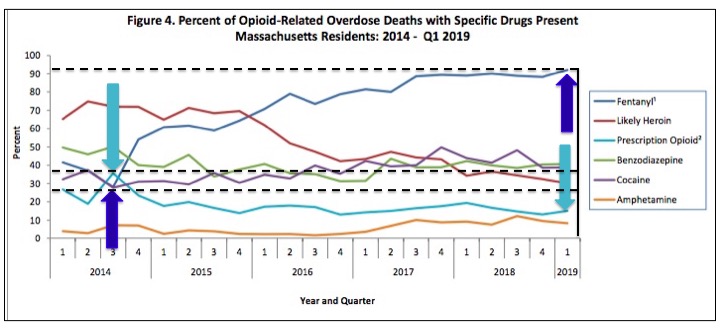
Figure 3. In mid-2014 (Massachusetts) prescription opioids (turquoise arrow) were present in more than 35% of tox samples. By 1Q 2019 that number had dropped to about 10%. Conversely, fentanyl was present in about 25% of samples in mid-2014 but by 1Q 2019 it was present in nearly all samples. Source: Massachusetts Department of Health.
TAKE HOME MESSAGES:
- Fentanyl gained a foothold in the US beginning in 2013 because there was a booming heroin market.
- Overdose deaths from all opioids rose steadily in Massachusetts between 2013-15, with fentanyl being a major factor.
- Even during this time, when fentanyl use was just beginning to take root in the US, legally prescribed prescription opioid narcotics were responsible for only a minor percentage of total opioid deaths.
- In Massachusetts between 2013-15 fentanyl was detected in about half of the people who died.
- By 1Q 2019 that number was >90%.
- It is virtually certain that when the 2013-15 numbers are updated to include 2017-19, the deaths from legally prescribed narcotics will be negligible.
- It is also a virtual certainty that almost all deaths will be due to fentanyl.
- By all means, let's keep suing opioid makers, restricting their manufacture and prescription. But don't expect this to change. Except maybe for the worse:
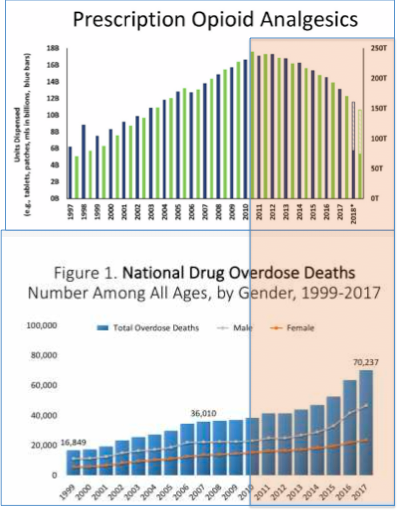
Source: (Top) Pain News Network/DA. (Bottom) National Institute on Drug Abuse
Keep your eyes on the orange box. Do you see any relationship between fewer prescriptions and more deaths?
Just asking.
NOTES:
(1) The crackdown is spreading. Now the DEA wants to dictate how much of which drug can be manufactured. Does this sound like a good idea? Didn't think so.
(2) My articles during this time have been compiled and categorized (See Analyzing The Opioid Crisis: 65 Articles By Dr. Josh Bloom).
(3) When I write "fentanyl" it does not mean pharmaceutical fentanyl, which is sold for severe pain in patches, candy, nasal sprays... in very small doses, typically a fraction of a milligram. I mean pounds/tons of illicit fentanyl and its analogs manufactured (mostly) in China. Pharmaceutical fentanyl is not a significant contributor to the carnage that is going on.
